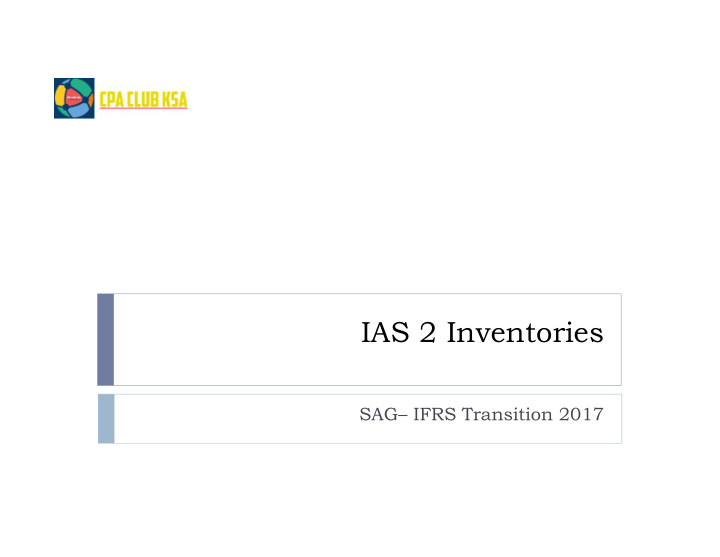



IAS 2 Inventories SAG– IFRS Transition 2017
Scope.. IAS 2 IAS 2 applies to the accounting for the following: 1. Held for sale in the ordinary course of business; (FG) 2. In the process of production for such sale; and (WIP) 3. In the form of materials or supplies to be consumed in the production process or in the rendering of services. (RM & Supplies/Tools)
Not applicable IAS 2 1. Work in progress arising under construction contracts, including directly related service contracts (IFRS 15) 2. Financial instruments (IFRS 9 Financial Instruments) 3. Biological assets related to agricultural activity and agricultural produce at the point of harvest (see IAS 41 Agriculture)
Definition.. IAS 2 Net RealizableValue Is the estimated selling price in the ordinary course of business less the estimated cost of completion and the estimated costs necessary to make the sale Fair value . The price that would be received to sell an asset or paid to transfer a liability in an orderly transaction between market participants at the measurement date.
SP1 Cost formula IAS 2 1. Specific identification method 2. FIFO (First in First Out) 3. Weighted Average 4. LIFO (Last in First Out) (Prohibited as per IAS 2)
Slide 5 SP1 Shijil P.Abdurahman, 5/2/2017
Recognition.. IAS 18 Inventories shall be measured at the lower of cost and net realizable value The cost of inventories shall comprise all costs of purchase, cost of conversion and other costs incurred in bringing the inventories to their present location and condition. Cost of Purchase The cost of purchase of inventories comprise the purchase price, import duties and other taxes, transport, handling and other costs directly attributable to the acquisition of finished goods, materials and services. Trade discounts, rebates and other similar items are deducted in determining the cost of purchase.
Recognition.. IAS 18 Cost of Purchase The cost of purchase of inventories comprise the purchase price, import duties and other taxes, transport, handling and other costs directly attributable to the acquisition of finished goods, materials and services. Trade discounts, rebates and other similar items are deducted in determining the cost of purchase. IAS 2 does not permit exchange differences arising directly on the recent acquisition of inventories invoiced in a foreign currency to be included in the costs of purchase of inventories.
Costs of Conversion Measurement The costs of conversion of inventories include costs directly related to the units of production, such as direct labour. also include a systematic allocation of fixed and variable production overheads that are incurred in converting materials into finished goods. The allocation of fixed production overheads to the costs of conversion is based on the normal capacity of the production facilities. The amount of fixed overhead allocated to each unit of production is not increased as a consequence of low production or idle plant
Costs of Conversion Measurement Costs items excluded from cost of inventories a) Abnormal amounts of wasted materials, labor or other production costs b) Storage costs, unless those costs are necessary in the production process before a further production stage c) Administrative overheads d) Selling costs e) Financing charges above purchase price for normal credit terms borrowing costs included if for a qualifying inventory item .However, borrowing costs will generally not be capitalized in connection with inventory acquisitions, since the period required to ready the goods for sale will generally not be significant. (IAS 23)
Measurement Joint products/ ByProducts Allocate between products on a rational basis such as relative sales value of products when they become separable If minor in value, do not allocate: measure by-product at net realizable value and deduct this amount from main product costs
Disclosure 1. The accounting policies adopted in measuring inventories, including the costing methods (e.g., FIFO or weighted-average) employed. 2. The total carrying amount of inventories and the carrying amount in classifications appropriate to the entity. 3. The carrying amount of inventories carried at fair value less costs to sell (inventories of commodity broker-traders). 4. The amount of inventories recognized as an expense during the period. 5. The amount of any write-down of inventories recognised as an expense in the period. 6. The amount of any reversal of any previous write-down that is recognised in profit or loss for the period. 7. The circumstances or events that led to the reversal of a write-down of inventories to net realisable value. 8. The carrying amount of inventories pledged as security for liabilities.
Disclosure
Disclosure
Goods in Transit FOB – Free On Board FOB Destination/Shipping Point FAS – Free alongside A seller who ships FAS (free alongside) must bear all expense and risk involved in delivering the goods to the dock next to (alongside) the vessel on which they are to be shipped. The buyer bears the cost of loading and of shipment; thus title generally passes when the carrier takes possession of the goods.
Cost Measurement Retail Method Standard Costs
IFRS Vs SOCPA Balance Sheet Statement of Financial Position Statement of Income Statement of Profit or Loss Statement of Other Comprehensive Income Statement of CashFlow Statement of CashFlow Statement of Changes Statement of Changes in Equity Shareholders Equity Notes to FS Notes to FS
Thanks www.cpaclubksa.com
Recommend
More recommend